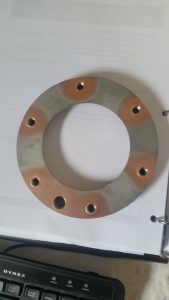Brazing & Soldering, How to
Brazing & Soldering-How is it done?
Brazing and soldering are two ways joining metal. Brazing and soldering are very similar and use basically the same procedure, with a few exceptions. The Brazing Book Online defines brazing as “the joining of metals through the use of heat and a filler material–one whose melting temperature is above 840 degrees F.” Aaroncake.net defines soldering as “the joining of metals by a fusion of alloys which have a relatively low melting point.” The difference is in the temperature. Brazing is done at temperatures above 840 degrees, and soldering is done at lower temperatures. Which one you do will affect what tools you choose? And whether you braze or solder depends on the material you’re working with and what you’re trying to accomplish with it. Brazing is used in situations where appearance and strength are crucial. The Brazing Book Online says that the wire frames for Ray-Ban sunglasses and the chairs made by Kreuger International of Green Bay, WI are manufactured using brazing.
Soldering is best used for electronics and some jewelry applications due to its lower heat. However, soldering does not produce the same level of strength as brazing
Instructions
Step 1
Make sure that the pieces you wish to join have a good fit and proper clearance. The Brazing Book says that “the strongest joint is achieved when the joint clearance is 00.15″” because it’s harder for the filler material to be distributed if the clearance is any narrower, and if the clearance is too wide, the filler material will not fill the joint completely.
Likewise, you need to make sure that components to be soldered are clean of any rust, dirt or oil. As for solder thickness, a few millimeters will do. You just need enough to hold the components firmly in place, but make sure that you don’t have big “globs” of solder and that you don’t have any “stray” solder touching other components.
Step 2
Clean the metals. The Brazing Book says that the pieces to be joined need to be clean. For metal that will be brazed, wipe it down with a clean cloth or use a suitable solvent if necessary to remove grease. In soldering, some people recommend using a mild solvent on a small piece of steel wool.
Step 3
Flux the parts (brazing only). Flux is a chemical compound that prevents metal from oxidizing when it is heated to high temperatures. If oxides form, they will prevent the filler material from bonding to the metal. Flux usually comes in a paste material that can be brushed onto the working surfaces of the metal.
Step 4
Assemble the parts to be brazed or soldered. You need to put them together. In some cases, you may need to hold or clamp the pieces together. In soldering, this means to place the components where you want to solder them on a circuit board.
Step 5
Braze or solder the assembly. The Brazing Book says to heat both pieces of the assembly uniformly and once you have them up to brazing temperature, deposit the filler material. It will melt and be drawn into the join through a process called capillary action.
Step 6
After you finish soldering or brazing, you need to do one final clean up. The Brazing Book recommends dropping your braze work in hot water and then brushing off any flaky residue with a wire brush.
To clean up your soldering, aaroncake.net recommends using steel wool dabbed into a little bit of mild solvent and gently dabbing the components.
Carlson Manufacturing Inc., has decades of experience with Brazing & Soldering. Contact us for assistance.
We also recommend Great Manufacturing, LLC.

